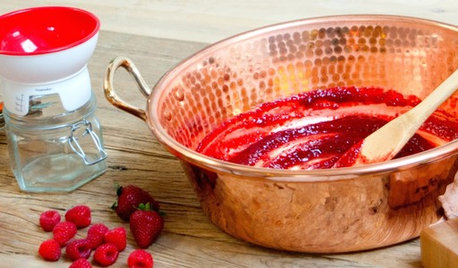How do I save tomato seeds?
zzackey
12 years ago
Featured Answer
Comments (18)
dickiefickle
12 years agolast modified: 9 years agodigdirt2
12 years agolast modified: 9 years agoRelated Discussions
How do I save seeds for next year?
Comments (4)The reason is that most hybrids seeds don't breed true and you will find many discussions scattered all over the forums on the problems associated with saving seeds from hybrids. They revert to one of the parent stock or a mutated form of one of them depending on the stability of the parent stock. Sure they will germinate and grow and the tomatoes they produce may be fine, then again they may not be. ;) Either way, the odds are they won't be the same. Open pollinated (often called heirlooms) breed true assuming there was no cross-pollination. Dave...See MoreHow to Clean & Save Tomato Seeds
Comments (1)Thanks Seedmama, I saved the PDF to my bookmarks! Keith...See MoreSaving the seeds from peppers (how do I know when they're mature?
Comments (17)Ok. Next year, hopefully, is my first year of not buying plants, because I couldn't get the one's I wanted this year. I live in a 'Flyover' area so my resources are limited. I bought the best resource book I knew of, and I'm following their directions. I'm Midwestern and hot foods do not appeal to me. I garden mostly by the rules that I was taught by my grandmother in the back yard garden. I am a Master Gardener who learns something new about growing (and sometimes killing things) all the time, and tries to share it. This isn't a competition. I'm just trying to help. Peace. Blue Cat....See MoreTomatoe seed saving. How many days do you soak?
Comments (14)Hi all - my method is pretty much like Maryliz's - courtesy of Organic Gardening magazine several years back..... I squeeze out the gel & seeds from the tomatoes I want to save seed from - into a clear glass custard cup, juice glass or small jar, add some water & cover loosely w/ a piece of foil & set it on my kitchen windowsill, over the sink & watch it until a scummy mold forms on top & most of the seeds sink to the bottom.This takes several days or a week, depending on how warm it is.When it's ready, I peel off the 'skin' & dump the rest into a fine mesh sieve & rinse well under the tap, then drain & knock the seeds off onto a china saucer & spread them out to dry.I usually put a little scrap of paper w/ the variety name on the plate too. I let them dry (inside, in a corner of my 'dining room')for a week or 2 & then store in labelled & dated pill bottles or mini zip bags....See Moredigdirt2
12 years agolast modified: 9 years agotrudi_d
12 years agolast modified: 9 years agocarolyn137
12 years agolast modified: 9 years agotrudi_d
12 years agolast modified: 9 years agotrudi_d
12 years agolast modified: 9 years agotrudi_d
12 years agolast modified: 9 years agocarolyn137
12 years agolast modified: 9 years agotrudi_d
12 years agolast modified: 9 years agozzackey
12 years agolast modified: 9 years agodickiefickle
12 years agolast modified: 9 years agotrudi_d
12 years agolast modified: 9 years agocarolyn137
12 years agolast modified: 9 years agodickiefickle
12 years agolast modified: 9 years agocarolyn137
12 years agolast modified: 9 years agob_kct
12 years agolast modified: 9 years ago
Related Stories

EDIBLE GARDENSSummer Crops: How to Grow Tomatoes
Plant tomato seedlings in spring for one of the best tastes of summer, fresh from your backyard
Full Story
SHOP HOUZZHouzz Products: Save a Taste of Summer
Can't bear to part with the flavors of summer peaches, berries and tomatoes? Then jam on it!
Full Story
GARDENING GUIDESHow to Plant a New Lawn From Seed
Choose from more grass varieties and save money over sod by starting your lawn from seed
Full Story
CONTAINER GARDENS8 Easy Container Plants to Grow From Seed
Get beautiful blooms and herbs in summer by starting these choice garden picks from seed in spring
Full Story
GARDENING GUIDESSeeds or Seedlings? How to Get Your Garden Started
Growing delicious herbs and vegetables starts with knowing your goals and when you want to plant
Full Story
LANDSCAPE DESIGNGet Along With Less Lawn — Ideas to Save Water and Effort
Ditch the mower and lower your water bill while creating a feast for the eyes with diverse plantings and gathering places
Full Story
LIFEThe Top 5 Ways to Save Water at Home
Get on the fast track to preserving a valuable resource and saving money too with these smart, effective strategies
Full Story
SAVING WATER6 Reasons Why You Should Save Your Rainwater Now
Collect and store during the rainy season so you’ll have water ready for irrigation when you need it
Full Story
GARDENING GUIDES8 Unthirsty Plants Help You Save Water in Style
Spend less effort and money on your landscape with drought-tolerant and native plants that liven up your yard
Full Story




digdirt2